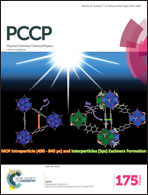Absorption intensity changes and frequency shifts of fundamental and first overtone bands for OH stretching vibration of methanol upon methanol–pyridine complex formation in CCl4: analysis by NIR/IR spectroscopy and DFT calculations
Abstract
Infrared (IR) and near infrared (NIR) spectra were measured for methanol and the methanol–pyridine complex in carbon tetrachloride. Upon the formation of the methanol–pyridine complex, the frequencies of both the fundamental and first overtone bands of the OH stretching vibration shifted to lower frequencies, and the absorption intensity of the fundamental increased significantly, while that of the first overtone decreased markedly. By using quantum chemical calculations, we estimated the absorption intensities and frequencies of the fundamental and first overtone bands for the OH stretching vibration based on the one-dimensional Schrödinger equation. The calculated results well reproduced the experimental results. The molecular vibration potentials and dipole moment functions of the OH stretching vibration modes were compared between methanol and the methanol–pyridine complex in terms of absorption intensity changes and frequency shifts. The large change in the dipole moment function was found to be the main cause for the variations in absorption intensity for the fundamental and first overtone bands.


 Please wait while we load your content...
Please wait while we load your content...